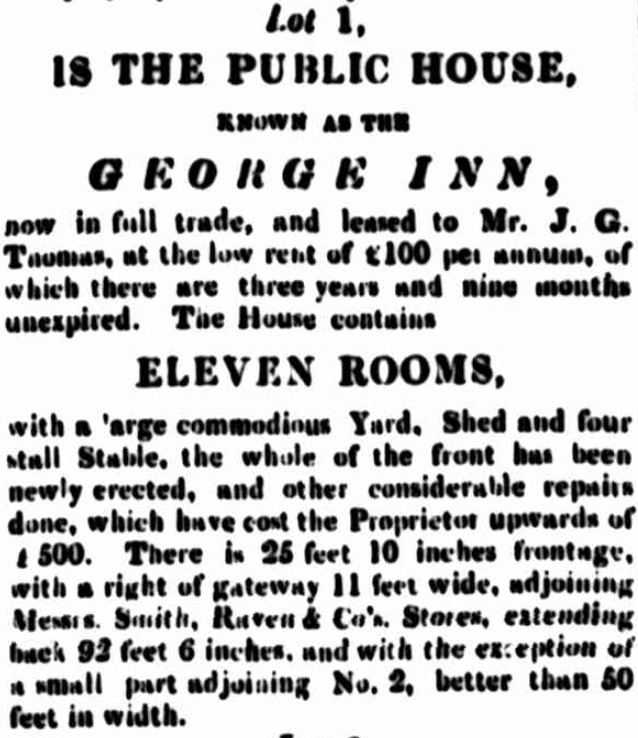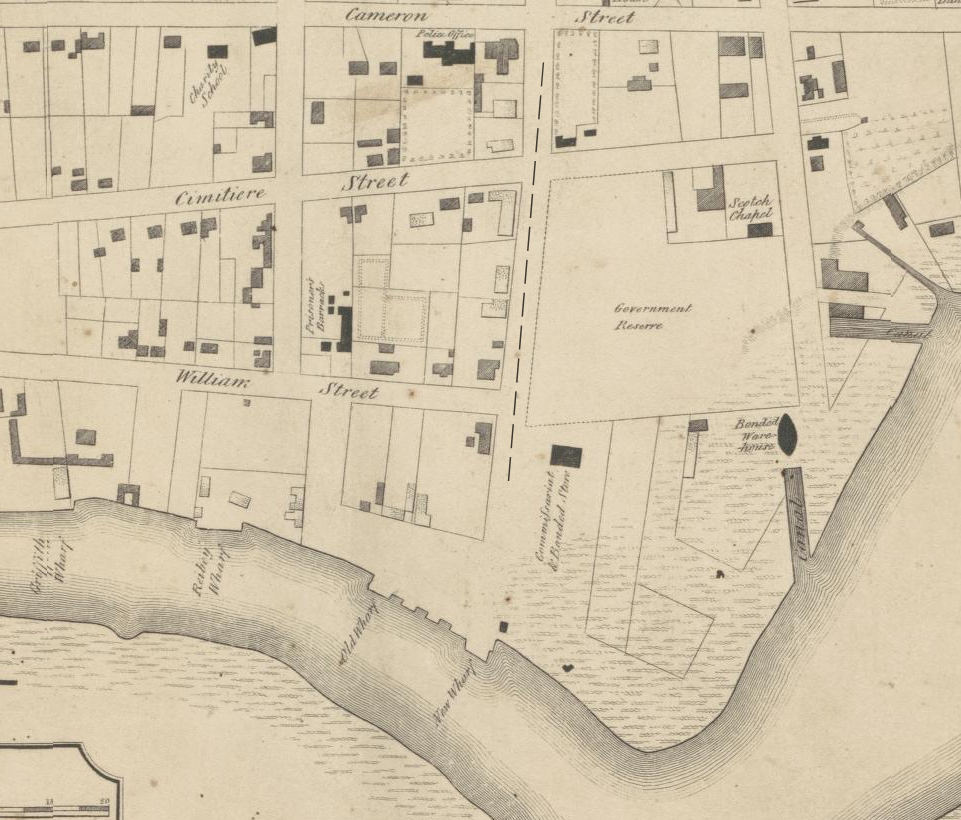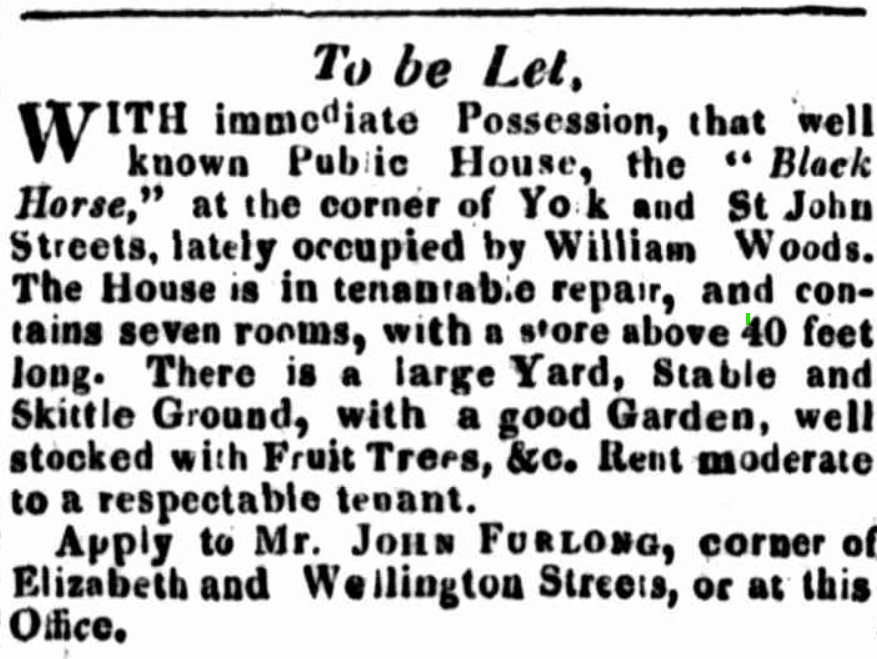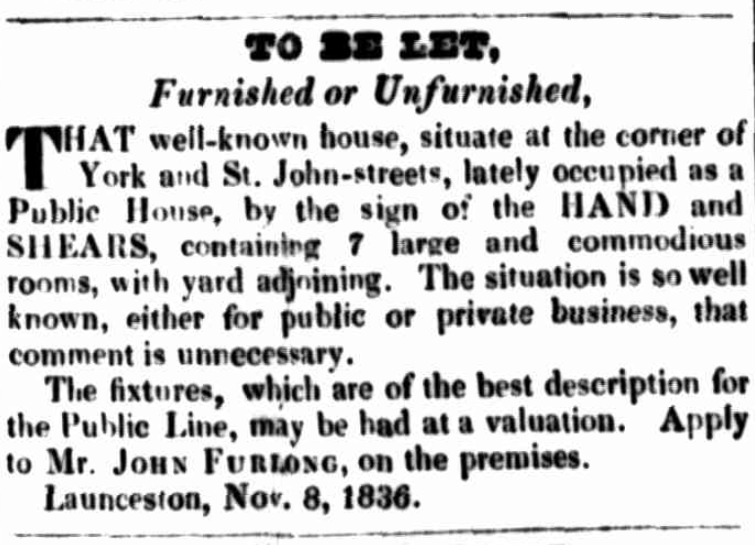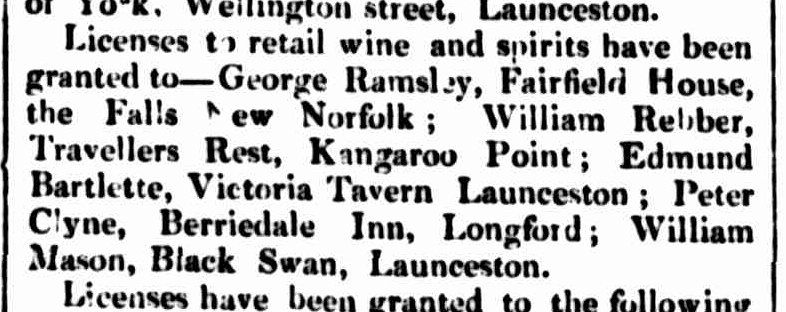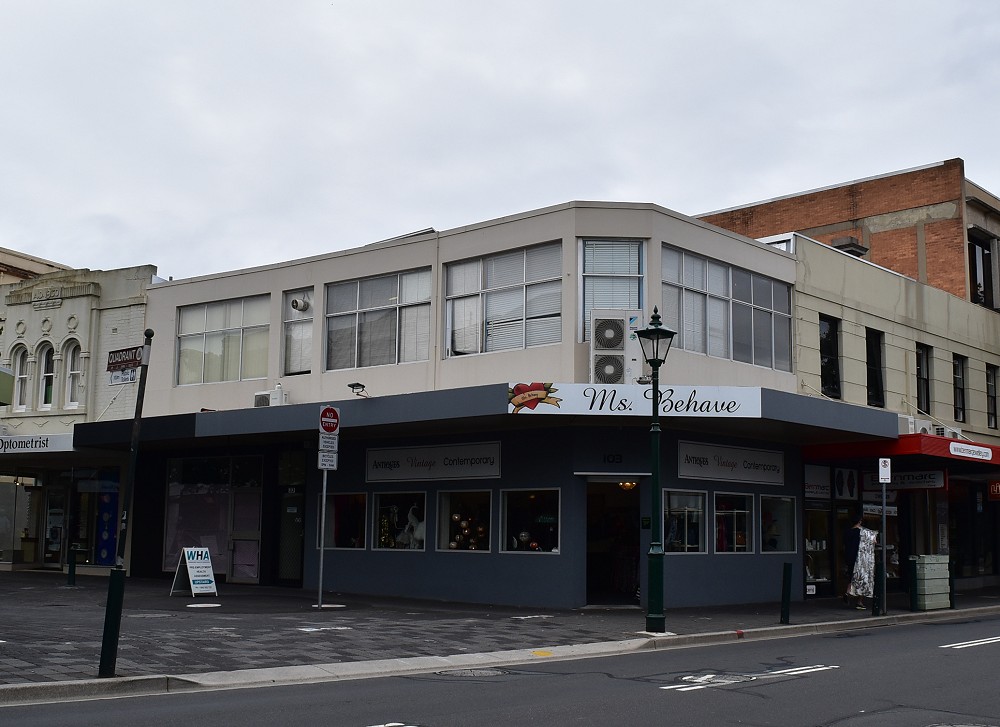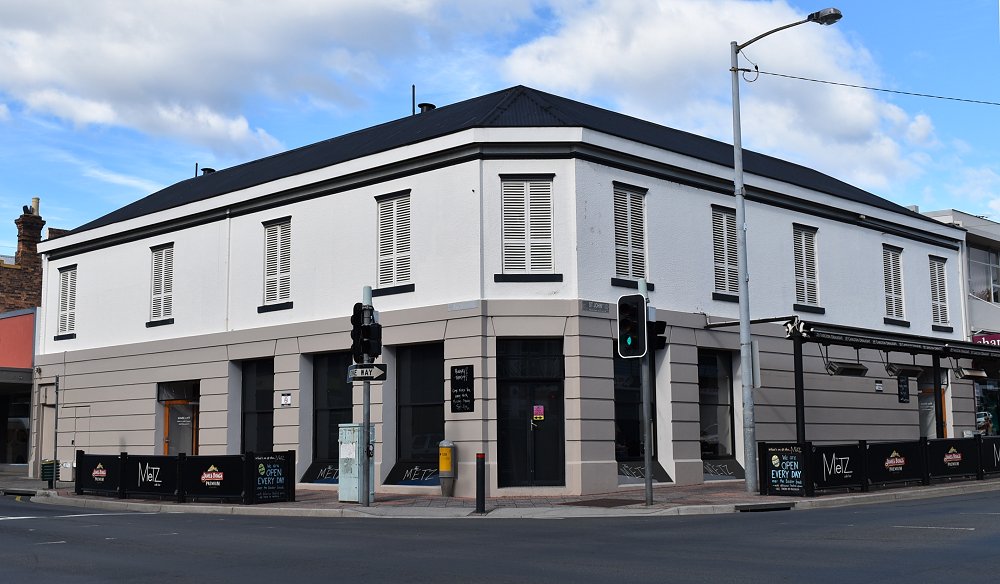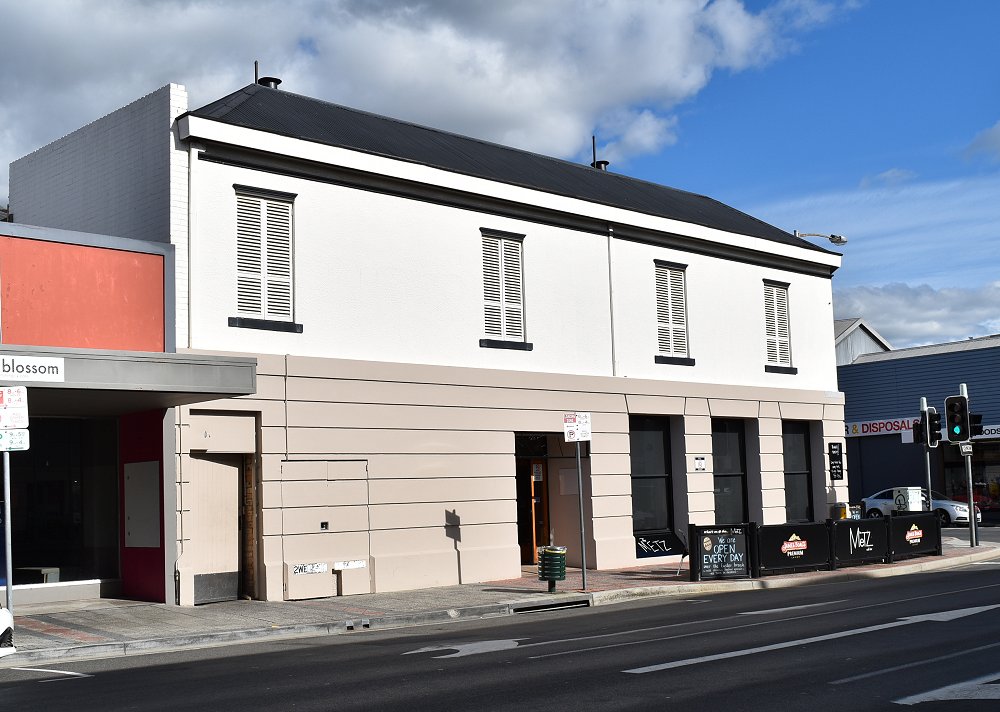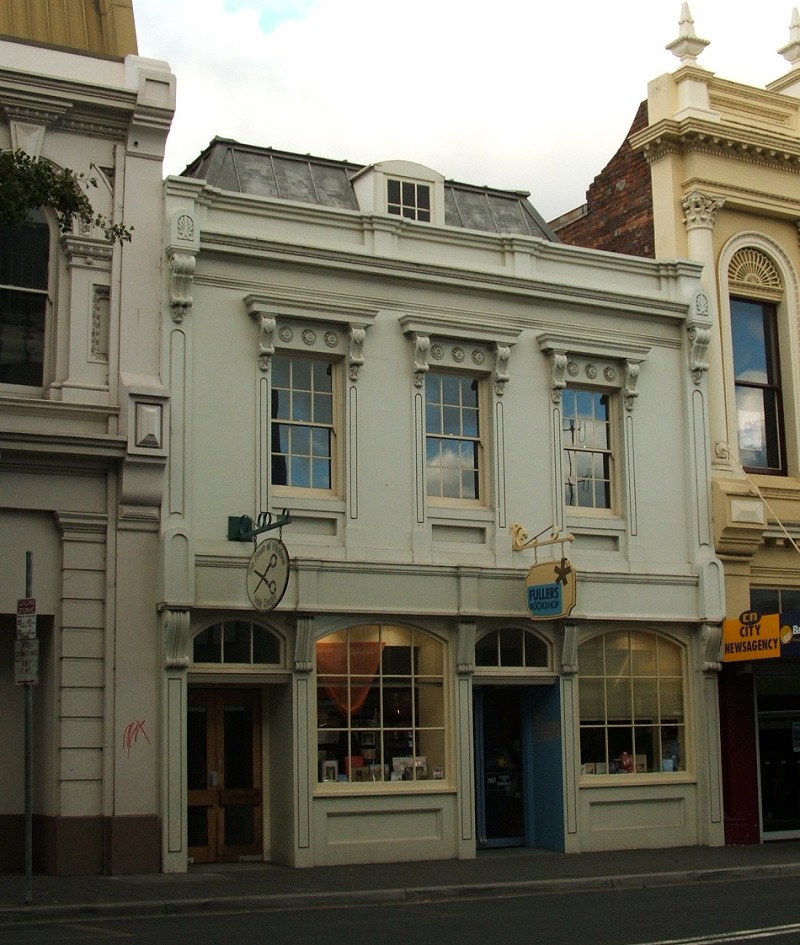NE corner of St John and Cameron Streets. Google Maps.

Cnr of St John & Cameron St, August 2016.
1830-33 London Tavern, George Sinclair Brodie, Cameron St
1833-37 Edmund Bartlett
1837 George Coulstock, London Tavern
1838-44 Benjamin Hyrons, London Tavern
1844 Nicholas Clarke, London Tavern
1844-48 Samuel Storey, London Inn/Hotel, St John & Cameron Streets
1849-51 Benjamin Walford, London Inn, Cameron & St John Streets
1851-55 Henry Godfrey, London Inn, St John & Cameron Streets
1855-58 George Adams, London Hotel, corner of St John and Cameron-streets
1859-60 David McQuestion, London Tavern, St John and Cameron Streets
1861-66 Charles Maryon Crooks, London Tavern, St John and Cameron Streets
1868-69 Feltham Bold Watson, London Family Hotel, St John and Cameron Streets
1870-71 Feltham Bold Watson, London Hotel, St John and Cameron Streets
Included the Olympic Theatre 1840s – 1850s.

Photo showing London Tavern, 1861-1866
(Cropped from an image in the QVMAG collection, QVM:1986:P:0803

Engraving of London Tavern, c.1870
(Not sure where I obtained this. It was in the folder where I keep material for this blog.)
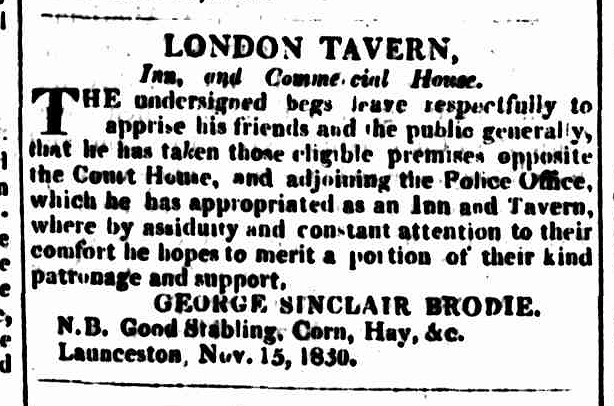
Hobart Town Courier, 27 November 1830
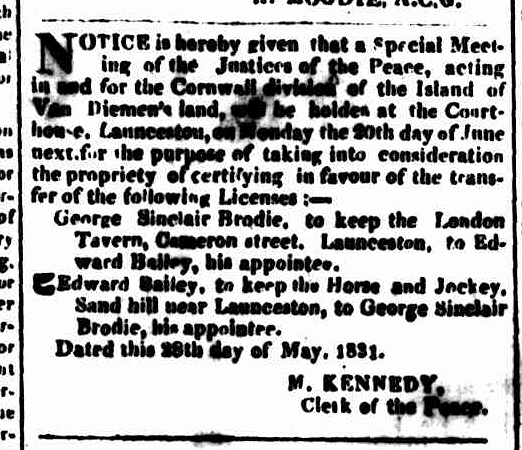
Hobart Town Courier, 4 June 1831

Launceston Advertiser, 10 October 1833

“Launceston Advertiser, 27 April 1837

Hobart Town Courier, 17 November 1837
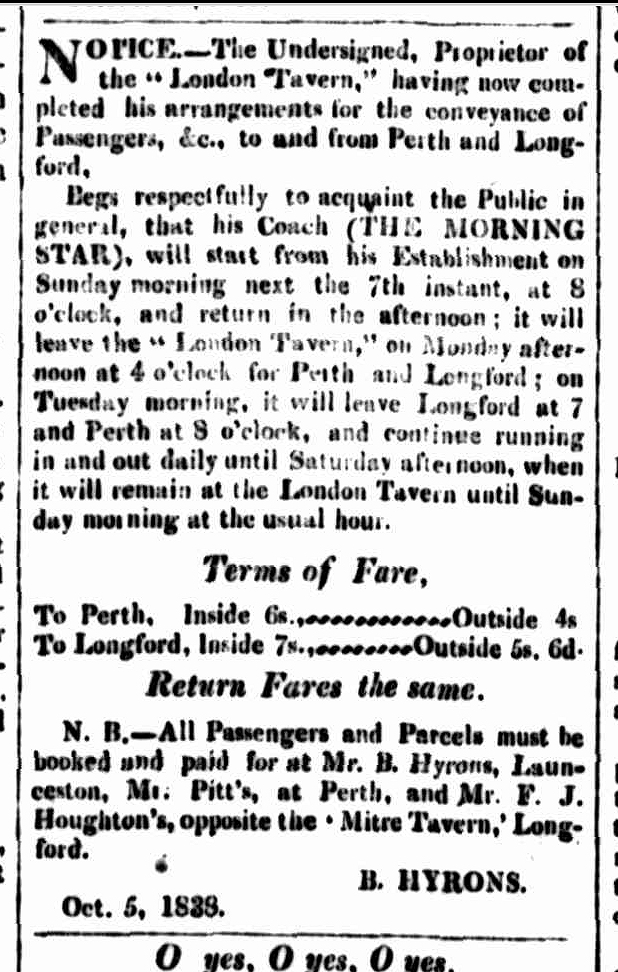
“Cornwall Chronicle, 3 November 1838

Launceston Courier, 5 September 1842
From “Licensing Day”:
Mr. Rocher, who appeared in support of the application, defended the couduct of his client [Nicholas Clarke], and contended that he had quilted the London Tavern merely from prudential motives, having, as it appeared, made the discovery that in resigning the Union for the above-mentioned house, he had made an unprofitable exchange.
Cornwall Chronicle, 4 September 1844
From “Annual Licensing Meeting”:
Samuel Storey, London Tavern.-One conviction, dirty, frequented by prostitutes.
It was pleaded that, as the theatre was held in Mr. Storey’s premises, an allowance ought to be made; but very little discussion followed, and the magistrates refused the license, reserving in favour of the applicant the opportunity of applying again at the quarterly meeting. Some discussion took place as to the grounds of refusal to be recorded. The clause of the act was read- from which it appeared, if the objection were made to the character of the applicant, he was debarred from renewing his application, and as no objection could be raised against the premises, it was by some considered, that they were bound to record the objection as being against character. This was disputed by others, some of whom wished to withdraw their votes, unless liberty were given to Mr. Storey to apply again. The votes were taken upon the question, and the majority were in favour of adopting course which enabled the applicant to apply again; but we could not collect what objection was recorded.
Launceston Examiner, 5 September 1846
From “Quarter Sessions”:
Mr. Douglas appeared for Mr. Storey of the “London Tavern,” and the license was granted with very little discussion.
Launceston Examiner, 23 September 1846
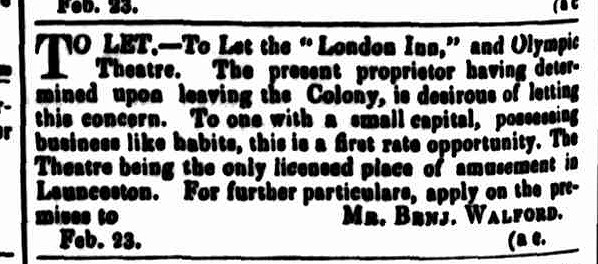
Cornwall Chronicle, 23 February 1850
The Theatre has, we understand, changed hands; Mr. Godfrey, of the “Horse and Jockey,” having rented the London Inn.
Cornwall Chronicle, 31 December 1850
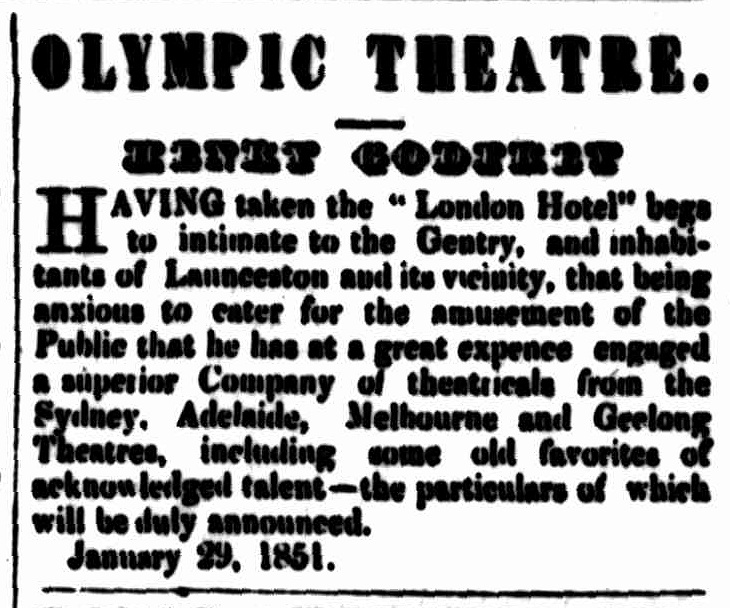
Cornwall Chronicle, 5 February 1851
H. Godfrey, London Inn, corner of St. John and Cameron-streets ; granted. The police magistrate had no objection to the house ; it was well conducted and cleanly, but he thought it would would be beneficial if theatrical performances were prohibited on the premises ; the play house was the primary cause of many irregularities, and he should endeavour to deprive it of a theatrical license.
Cornwall Chronicle, 4 September 1852

Cornwall Chronicle, 28 June 1854

Cornwall Chronicle, 11 March 1857

Cornwall Chronicle, 23 February 1859
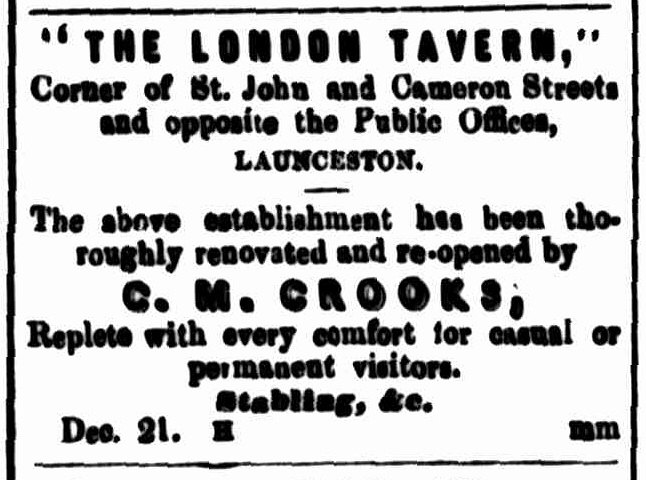
Cornwall Chronicle, 21 December 1861

Cornwall Chronicle, 29 June 1864
Charles Maryon Crooks, London Tavern, Cameron and St. John-streets.
The police magistrate said he must most decidedly object to this application. The house was dirty and badly kept; there was great regularity; there were complaints of the house being kept open all night, and reports of prostitutes frequenting it, and altogether there was not a worse conducted house in town.
Mr. Rocher appeared in support of the application. He said the house, on account of its proximity to the Police Office, and municipal buildings, was in a position where stricter surveillance could be exercised than on any other house in town, and yet there had only been one conviction during the year. Then frequently there were entertainments going on at the Mechanics’ Institute and Town Hall, and Mr Crooks could not help persons coming from those entertainments to his house. As for the reports respecting persons of bad character frequenting the house, why had not informatlons been laid against Mr. Crooks for the Police Act was stringent enough. If the house was badly conducted it was the fault of the police. After some further remarks, Mr. Rocher appealed through the Chairman to the Superintendent of Police as to the manner in which the house was conducted. The Superintendent of Police said he could fully bear out what Mr. Gunn had stated.
The Police Magistrate, referring to Mr. Rocher’s remarks respecting the house being close to the Police Office, said that the Police Office closed at 4 o’clock in the afternoon, whilst the irregularities took place at night.
The licence was refused.
Mr. Rocher submitted that evidence should be given of the irregularities mentioned: a mere re port or complaint was not sufficient. The Chairman said this had never been the practice here.
Launceston Examiner, December 1865
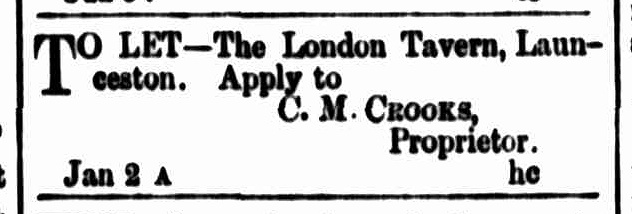
Cornwall Chronicle, 5 January 1867
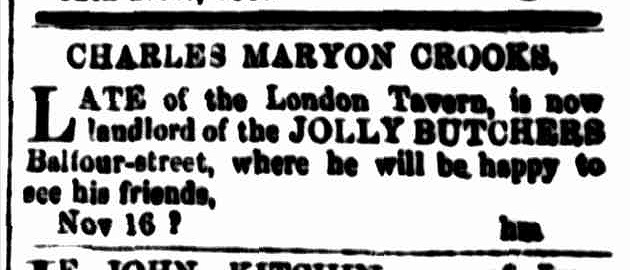
Cornwall Chronicle, 16 November 1867
The Annual Licensing Meetings will be held on Monday next. Amongst the applications is one from Mr Alfred Stephen Harris for a license to the house at the corner of Bathurst and York-streets, formerly “Lamb and Flag.” Mr Hely intends to alter the designation of “The Ship Inn,” Wharf, to that of “The Duke of Edinburgh,” and Mr Walter Harris intends to alter the title of his new premises at the corner of Charles and Patterson-streets from “The Turf Hotel” to the “Plough Inn.” Mr W. F. Green applies for a. license for “The London Tavern,” St. John and Cameron streets, and Mr Robert Fox Mitchell for a license for “The O’Connell Inn,” Wellington and Frankland streets.
Cornwall Chronicle, 30 November 1867

Cornwall Chronicle, 4 December 1867
THE LONDON HOTEL — This Hotel, next to the Public Buildings, Launceston,has been taken by Mr. F. B. Watson, formerly of Longford. It is to be newly fitted up as a General and Family Hotel. The London Hotel is very conveniently situated for Visitors from the adjoining Colonies, being close to the Post-office, Town ball, Mechanics’ Institute, Public Buildings, and all the Banks.
Cornwall Chronicle, 18 January 1868
From “Annual Licensing Meeting, Launceston”:
Feltham Bold Watson, London Hotel, St. John and Cameron-streets
The Mayor said this house was so very much out of repair; so much so that it was impossibly to keep it in good order. He would recommend that a note be made of this for the information of the landlord.
The Tasmanian, 9 December 1871
DANGEROUS BUILDING.
The Mayor said the Building Surveyor had thought it his duty to present a report with respect to the building opposite the Town Hall known as the London Tavern, which he would request the Town Clerk to read. Letter read as follows:–
Building Surveyor’s Office,
23rd September, 1872.
To the Worshipful the Mayor and Alderman
GENTLEMEN–I beg to report that having examined the structure at the junction of Cameron and St. John-streets known as the “London Tavern”, I consider it to be in a dangerous state, and nature of former alterations and the fact that it overhangs the footpath in St. John-street, I am of opinion that it cannot be shored up, or otherwise secured. I therefore recommend that it be at once taken down.– I have the honor to be, gentlemen, your obedient servant,
G. Babington
The Mayor said on looking over the Building Act as to what action, the council should take it appeared the surveyor should, with any other competent surveyor, examine the building and report to the council that day week, giving a certificate of his opinion as to the condition of the structure; and on that the Council would come to a decision how to act. His Worship added that he had had it under his own eyes, for some time, and if the Council would notice the roof, they would see the rafters were coming apart from the wall plates, and the end wall and front very much bulged out.
Alderman Murphy moved that the action prescribed by the Building Act be taken.
Alderman Hart seconded, and remarked that it was a matter of importance to be attended to at once, as the building in question was on the street line, and no doubt it was dangerous, and the Council would be culpable it they did not take action.
Alderman Webster–The building has not been occupied for some time, I believe?
The Mayor–Not since Mr Watson left.
The resolution for the building to be inspected inside and out by the Surveyor and another competent surveyor, and to report on Monday next, furnishing a certificate, was then agreed to.
Launceston Examiner, 24 September 1872
I see the Council are at last moving about the old London Tavern, and not a bit too soon, for the place has been gradually falling for some considerable time past. I have had many opportunities of observing it from the Cameron street stand and I have often had a good look at it and speculated as to how soon it would be before it came toppling over into the street, and how many people It would be likely to kill in its fall !
Launceston Examiner, 28 September 1872
THE LONDON TAVERN
The Mayor referred to the correspondence with Mr Cameron as to the London Tavern. Mr Cameron said he had made a commencement inside the building, and the putting down would be proceeded with as soon as certain arrangements had been made. His Worship said he saw Mr Cameron on the 10th November and he asked him to delay the matter as he was making an arrangement with Mr Titmus for removing the building; but time was wearing on and nothing had been done. In his (the Mayor’s) opinion the building should be proceeded with at once, and if not done by the owner probably he (the Mayor) ought to take more active steps.
Alderman Douglas said he was aware Mr Titmus had been in communication with Mr Cameron, and as far as Mr Cameron was concerned he had left it to Mr Titmus.
Alderman Webster suggested that the Mayor should see Mr Titmus, and if he not the power to act, Mr Cameron could then be applied to.
The matter then dropped.
Launceston Examiner, 3 December 1872
Almost the first start given to theatrical enterprise in Launceston was the leasing of the old Olympic Theatre by Mr. George Coppin, who may truly be designated as one of the foremost pioneers of the drama throughout the Australian colonies. The Theatre Royal Olympic, which was in those days the principal place of amusement in Launceston stood at the corner of St. John and Cameron streets, directly opposite where the Town Hall now is. Connected with it was the London Tavern, and altogether it was rather a primitive description of structure to be the principal home of the drama in a town. However, a great number of plays, most of them being of the “blood and thunder class,” containing as Henry James Byron, the talented author of the popular comedy “Our Boys,” describes it, “An opening chorus about glorious wine, a broad sword combat every sixteenth line,” were produced here by various companies, and the audiences as a rule were numerous and appreciative. On the 3rd of March, 1845, George Coppin first took up the reins of management in Launceston, and brought out most of the popular farces and comedies of the day with success. Previous to this date, however, we find that dramatic companies and various other classes of public entertainments frequently visited the town, while now and then the amateur societies, most of which were connected with the military regiments that were stationed here, occupied the boards of the local theatre. Thus in 1844 we find the amateurs connected with the 86h regiment giving a benefit on behalf of the poor of Launceston, at the Olympic Theatre, and producing Oliver Goldsmith’s comedy ” She Stoops to Conquer,” and the burlesque “Bombastes Furioso.” On Monday, April 22, 1844, Mrs. Clarke, lessee of the Victoria Theatre, Hobart (now the Theatre Royal), commenced a dramatic season here, her company being composed of Rogers, one of the best character actors the world has over produced, Young, F. Howson, and others. The opening piece was the ” Country’ Squire,” in which Rogers sustained the leading part. On Monday, February 3, 1844, Professor Rea, a ventriloquist and mimic, appeared at the Olympic for a few nights in a variety entertainment. Various companies occupied the boards of this Theatre until 1856, when the Lyceum Theatre was opened on May 20, under the management of Mr. Jones Melville.
Launceston Examiner, 27 May 1882
OBITUARY.-Our George Town correspondent reports the death yesterday morning of a well-known resident, Mr. Feltham Bold Watson, Mr. Watson was an actor and manager in his earlier days, and first came to Launceston from Hobart, He rented and improved the old Lyceum Theatre, a wooden structure that stood on the ground fronting on Cameron-street, near the Bank of Tasmania, now occupied by Capt. S. Tulloch’s new stores, and he introduced several good actors to the Launceston public. He afterwards had a good deal to do with the old Theatre Royal in St. John-street, and was the last landlord of the well-known London Tavern, which stood on the corner allotment opposite the Town Hall. He resided at Longford for a time, and some ten or twelve years ago removed to George Town, where he has since resided.
Launceston Examiner, 10 January 1884
The old London Tavern and Theatre stood at the corner of St. John and Cameron streets, where the Post-office is now situated. The theatre was a properly constructed one, but small. It was in the London Theatre that Mr George Coppin, now the hon. Mr Coppin, played so frequently when in Tasmania, and there also Rogers, one of the finest character actors the world has produced, had portion of his early stage training. George Herbert Rogers was the son of a Wesleyan minister in England. Disliking the monotony of home life he ran away and joined the army. His regiment was sent out to this island, and he became an expert amateur actor during his sojourn at Hobart. Ultimately his discharge was purchased and he entered the theatrical profession. The early records of the Melbourne stage tell us that on June 14, 1845, a small coasting vessel called The Swan dropped anchor in the Yarra, bringing over from Launceston Mr and Mrs George Coppin and their company. The members of that company comprised Mr and Mrs Rogers, Mrs Thompson, Mr and Mrs Hambleton, Mr Thompson, Mr Opie, the scene painter, and a small orchestra led by Mr Megson. Charles Young, an exceedingly clever actor, was also with him. This talented company had been playing at the London Theatre, Launceston.
Launceston Examiner, 22 December 1894
From “Early Launceston, Mr Whitfield’s Lecture, No. 5.”
Still following along St. John-street, we come to its intersection with Cameron-street, Post-office corner. Here stood the London. Tavern, on the signboard of which was at one time depicted a view of London and St. Paul’s, but afterwards altered to the London Coat of Arms. The last landlord was F. B. Watson, who was at one time associated with the stage. On the top storey of the London was a comical little theatre, the Olympic I believe it was called, but it fell into disuse after the erection of the Theatre Royal in St. John-street, where the Bijou now stands.
Launceston Examiner, 8 July 1897

